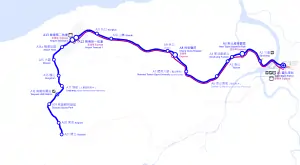Taoyuan Airport MRT
Taiwan Taoyuan International Airport MRT (Mass Rapid Transit), commonly known as the Airport MRT, is a rapid transit line of Taoyuan Metro that connects the municipalities of the capital Taipei, Taoyuan, and New Taipei with Taoyuan International Airport. The 51.33 km (31.89 mi) line, from Taipei Main Station to Huanbei, has 22 stations and began commercial service on 2 March 2017.
| Taoyuan Airport MRT | |||
|---|---|---|---|
 Taoyuan Metro Commuter Train (left) and Express Train (right) | |||
| Overview | |||
| Other name(s) | Taiwan Taoyuan International Airport Access MRT System | ||
| Native name | 桃園機場捷運 | ||
| Locale | Taipei, Taoyuan, New Taipei | ||
| Termini | |||
| Stations | 22 (Starting July 2023) | ||
| Service | |||
| Type | Rapid transit | ||
| Operator(s) | Taoyuan Metro Corporation | ||
| Depot(s) | Qingpu Depot, Luzhu Depot | ||
| Rolling stock |
| ||
| Daily ridership | 64,000[2] | ||
| History | |||
| Opened | 2 March 2017 | ||
| Technical | |||
| Line length | 51.33 km (31.89 mi) | ||
| Character | Elevated and Underground | ||
| Track gauge | 1,435 mm (4 ft 8+1⁄2 in) standard gauge | ||
| Electrification | 750 V DC third rail | ||
| Operating speed | 100 km/h (62 mph) | ||
| Signalling | Siemens Trainguard MT CBTC (ATC, ATO, ATP)[3] | ||
| |||
| Taiwan Taoyuan International Airport MRT | |||||||||||||||||||||
|---|---|---|---|---|---|---|---|---|---|---|---|---|---|---|---|---|---|---|---|---|---|
| Traditional Chinese | 臺灣桃園國際機場聯外捷運系統 | ||||||||||||||||||||
| Simplified Chinese | 台湾桃园国际机场联外捷运系统 | ||||||||||||||||||||
| |||||||||||||||||||||
| Taoyuan Airport MRT | |||||||||||||||||||||
| Traditional Chinese | 桃園機場捷運 | ||||||||||||||||||||
| Simplified Chinese | 桃园机场捷运 | ||||||||||||||||||||
| |||||||||||||||||||||
The line features Commuter and Express services as well as in-town check-in and baggage check at Taipei Main Station[4] and at New Taipei Industrial Park.[5]
An extension to Zhongli railway station via Laojie River from the current terminus at Huanbei is under construction, with the Laojie River metro station opened in July 2023 and the full extension scheduled for completion in 2028.[6]
Route
The Taoyuan Airport MRT route starts from Taipei Main Station and heads west, passing through Sanchong, Taishan, Xinzhuang, Guishan, Linkou, and Luzhu before reaching Taoyuan International Airport, after which the route turns south to Taoyuan HSR station before terminating at Huanbei in Zhongli.[7] The route is currently 53.07 km (32.98 mi) long[8] with 21 total stations,[4] of which 6 are underground and 15 are elevated;[9][note 1] approximately 12.96 km (8.05 mi) of the line is underground while the remaining 40.11 km (24.92 mi) is elevated.[8] There are two maintenance depots along the line;Qingpu Depot (near Linghang) and Luzhu Depot (near Kengkou.)[8]
Operations
Taoyuan Airport MRT | |||||||||||||||||||||||||||||||||||||||||||||||||||||||||||||||||||||||||||||||||||||||||||||||||||||||||||||||||||||||||||||||||||||||||||||||||||||||||||||||||||||||||||||||||||||||||||||||||||||||||||||||||||||||||||||||||||||||||||||||||||||||||||||||||||||||||||||||||||||||||||||||||||||||||||||||||||||||||||||||||||||||||||||||||||||||
|---|---|---|---|---|---|---|---|---|---|---|---|---|---|---|---|---|---|---|---|---|---|---|---|---|---|---|---|---|---|---|---|---|---|---|---|---|---|---|---|---|---|---|---|---|---|---|---|---|---|---|---|---|---|---|---|---|---|---|---|---|---|---|---|---|---|---|---|---|---|---|---|---|---|---|---|---|---|---|---|---|---|---|---|---|---|---|---|---|---|---|---|---|---|---|---|---|---|---|---|---|---|---|---|---|---|---|---|---|---|---|---|---|---|---|---|---|---|---|---|---|---|---|---|---|---|---|---|---|---|---|---|---|---|---|---|---|---|---|---|---|---|---|---|---|---|---|---|---|---|---|---|---|---|---|---|---|---|---|---|---|---|---|---|---|---|---|---|---|---|---|---|---|---|---|---|---|---|---|---|---|---|---|---|---|---|---|---|---|---|---|---|---|---|---|---|---|---|---|---|---|---|---|---|---|---|---|---|---|---|---|---|---|---|---|---|---|---|---|---|---|---|---|---|---|---|---|---|---|---|---|---|---|---|---|---|---|---|---|---|---|---|---|---|---|---|---|---|---|---|---|---|---|---|---|---|---|---|---|---|---|---|---|---|---|---|---|---|---|---|---|---|---|---|---|---|---|---|---|---|---|---|---|---|---|---|---|---|---|---|---|---|---|---|---|---|---|---|---|---|---|---|---|---|---|---|---|---|---|---|---|---|---|---|---|---|---|---|---|---|---|---|---|---|---|---|---|---|---|---|---|---|---|---|---|---|---|---|---|---|---|---|---|---|
| |||||||||||||||||||||||||||||||||||||||||||||||||||||||||||||||||||||||||||||||||||||||||||||||||||||||||||||||||||||||||||||||||||||||||||||||||||||||||||||||||||||||||||||||||||||||||||||||||||||||||||||||||||||||||||||||||||||||||||||||||||||||||||||||||||||||||||||||||||||||||||||||||||||||||||||||||||||||||||||||||||||||||||||||||||||||
| Times shown are for trips originating from Taipei Main Station. | |||||||||||||||||||||||||||||||||||||||||||||||||||||||||||||||||||||||||||||||||||||||||||||||||||||||||||||||||||||||||||||||||||||||||||||||||||||||||||||||||||||||||||||||||||||||||||||||||||||||||||||||||||||||||||||||||||||||||||||||||||||||||||||||||||||||||||||||||||||||||||||||||||||||||||||||||||||||||||||||||||||||||||||||||||||||
Two types of services are offered: Commuter and Express. Commuter Trains have a blue livery and stop at all stations while Express Trains have a purple livery and focus on serving passengers using Taoyuan International Airport (TPE), stopping at just two stations between Taipei Main Station and the airport.[7] Express Trains reach TPE from Taipei Main Station in 35 to 37 minutes depending on the terminal, with a 15-minute headway during peak times and a 30-minute headway off-peak.[10] While nearly all Express Train services only run between Taipei Main Station and TPE, a few services[note 2] during weekday rush hours and weekend afternoons run the full route to Huanbei with only one additional stop at Taoyuan HSR station, serving the entire route in 64 minutes. Commuter Trains have a 15-minute headway at all times and serve the full route in 82 minutes.[10]
Express Trains have transverse row seating with underseat storage for luggage as well as three luggage racks per car; Commuter Trains have longitudinal seating without underseat storage and only have two luggage racks per car.[11] Both services feature free wi-fi[12] as well as flight information display systems showing status of departing flights at TPE, although there are more displays on Express Trains.[8] Express Trains also offer wireless charging stations.[13]
In-Town Check-In
In-town check-in and baggage check services are available at Taipei Main Station[4] and New Taipei Industrial Park.[5] Baggage handling equipment is installed, including check-in counters, conveyor belts, container handling equipment, container elevators, and control systems.[14] Baggage is transported from the check-in counter into containers, which are loaded onto Express Trains. Checked baggage is delivered to Terminal Two, where it is scanned and directed to the appropriate airline.[15]
Flight information
Flight information display systems, which also carry information on TRA and THSR services from transfer stations, are installed at all stations served by Express Trains from Taipei Main Station to TPE, as well as at Taoyuan HSR station.[16][17]
Fares
Fares on the Taoyuan Airport MRT are based on distance traveled and there is no fare difference between Commuter and Express services.[18] Published one-way fares range from NT$30 to NT$160, with fares from Taipei Main Station to TPE priced at NT$160 and fares from Taoyuan HSR station to TPE priced at NT$30.[18] Since October 2018, a NT$10 promotional discount on all published one-way fares has been applied due to the operational profitability of the line since service began.[19]
30, 60, 90, and 120-day periodic tickets allowing unlimited rides on the Taoyuan Airport MRT within specified station pairs are available, priced at a 30, 35, 40, or 50% discount, respectively,[20][21] on the price of 21 published round-trip fares between the specified station pairs per 30-day period (21 being the approximate average number of weekdays per month).[18]
Trips between airport stations, and between the airport stations and the airport hotel station, are free when using an IC card at the automatic gates.[22]
Rolling stock
Passenger electric multiple units
Kawasaki manufactured all Express trains and seven Commuter train sets in Japan, while Taiwan Rolling Stock Company (TRSC) manufactured the remaining Commuter train sets.[23][24] The car body is constructed from stainless steel[14] and each car is supplied with 750 V DC electricity from a third rail,[14] powered by IGBT–VVVF inverters and conventional 3-phase AC induction motors provided by Mitsubishi Electric, and controlled with Siemens Mobility's Trainguard MT communications-based train control (CBTC) system,[3] which has subsystems of automatic train control (ATC), automatic train operation (ATO) and automatic train protection (ATP).[25]
Of the 41 train sets, 18 are Express trains while 23 are Commuter trains.[26] Four-car configurations are used for Commuter Trains, while Express Trains have five-car configurations due to an extra baggage car.[27] Commuter Train cars have 50 longitudinal seats with two wheelchair areas and two luggage racks. Express Train cars are equipped with 54 seats with one wheelchair area and three luggage racks.[27] Each train car has three doors per side except for baggage cars which have five doors per side; baggage cars have an onboard baggage handling system including control equipment.[27]
Fleet roster
All trains have open-gangway connections.
| Class | Image | Year built | Builder | Capacity | Routes operated | Formation | Top speed (km/h) | Fleet total | Set numbers | |
|---|---|---|---|---|---|---|---|---|---|---|
| Design | Service | |||||||||
| 1000 | 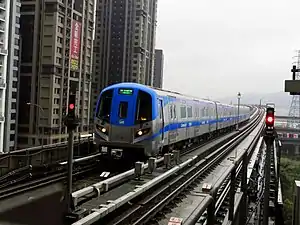 |
2011– | Kawasaki TRSC[lower-alpha 1] |
1116 | Commuter | 4-car sets DM1-M1-M2-DM2 |
110 | 100 | 23[lower-alpha 2] | 1001~1023[lower-alpha 3] |
| 2000 | 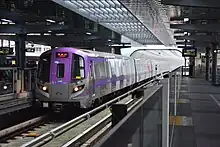 |
Kawasaki | 855 | Express | 5-car sets DM1-M1-M2-M3-DM2 |
18[lower-alpha 4] | 2001~2018[lower-alpha 5] | |||
Engineering trains
Taoyuan Metro uses a specialized fleet of engineering trains supplied by Hokuriku Heavy Industries for maintenance of way. Some of these trains include rail crane wagons,[28] rail inspection vehicles,[29] and 60-ton rescue locomotives.[30]
In April 2017, Taoyuan Metro borrowed an ultrasonic flaw detection vehicle from Taipei Metro to conduct comprehensive inspections on its rail tracks after a crack was discovered on a track point at the emergency halt between Linkou and Shanbi. At that time, Taoyuan Metro only had a hand-pushed ultrasonic inspection device for such purposes.[31]
History
A rail system to connect Taoyuan International Airport with existing transportation hubs was proposed as early as the 1980s[32] and reemphasized over the years in government proclamations such as the New Ten Major Construction Projects.
The metro route was originally planned to be constructed as a BOT project; in 1998, the project was auctioned to Evertransit International Development Corp. (長生國際開發), a subsidiary of Ever Fortune Industrial Co. (長億實業). However, the company failed to begin the construction, and in 2003, the government cancelled the contract.[7] After the BOT project failed to go through, the Ministry of Transportation and Communications (MOTC) decided to build the line directly from the government budget.
MOTC originally planned for the line to be transferred to the Taiwan Railway Administration (TRA) to operate; President Ma Ying-jeou had also proposed the Bureau of High Speed Rail (BOHSR)[note 3] to operate the line with the Taipei Rapid Transit Corporation (TRTC) and the TRA. Later, the TRA announced they would not be able to operate the line so the MOTC asked TRTC to operate the line or have the Taoyuan City Government create the Taoyuan Rapid Transit Corporation to operate the line.
Taipei terminus change and design
The terminus in Taipei was originally planned for Ximen but was changed to Taipei Main Station to facilitate transfers to TRA, THSR, and Taipei Metro, as well as other transportation modes[33] including bus services at the adjacent Taipei Bus Station. However, there were disagreements between MOTC and the Taipei City Government over the precise location of the station platform within the Taipei Main Station area; MOTC preferred an elevated platform just north of Taipei Main Station while the city wanted an underground platform just west of the main station, across Chengde Road. The MOTC's elevated platform proposal was less expensive and faster to construct, but the city objected as the platform and track would have obstructed the scenery of the surrounding area. The two sides eventually compromised, agreeing to the underground platform proposal but with the Taipei City Government covering the additional cost. The revised project was approved in September 2004.[7]
The Taipei Main Station terminus of the Taoyuan Airport MRT was built under the future Taipei Towers development[34] and was designed by architect Fumihiko Maki.[35] The station itself extends five stories underground.[36] The diaphragm wall is 53 metres (174 ft) deep and excavation depth was around 27 metres (89 ft). Four underground levels were constructed: three for the terminus of the station and one for a parking lot.[37] China Engineering Consultants, Inc. (CECI) won the contract for construction of the Taipei City section of the Taoyuan Airport MRT, including construction of the station and platform at the Taipei terminus, through public appraisal on 8 July 2005.[33] Redevelopment of the 47 hectares (470,000 m2) area will consist of retail, office, and hotel components.[36]
Construction and development
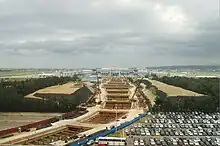
The BOHSR of the MOTC oversaw construction,[38] which began in 2006 and was scheduled for completion in 2013 but was plagued by multiple delays.[39] The entire system was budgeted at NT$113.85 billion.[40]
Land acquisition for the Sanchong City section totaled 2.07 ha (20,700 m2) and cost NT$1.4 billion, including land and buildings.[41]
In addition to tracks and stations, joint development projects have been constructed to boost development around stations. A special industrial zone was planned around the THSR Taoyuan Station area.[42] In April 2011, Kingdom Construction Corp. signed a contract to construct a 16-story residential and commercial building near Linkou Station.[43]
Civil engineering
The design of core E&M systems (including rolling stock, power supply, signaling, communications, depot equipment, platform screen doors, etc.) and the design and construction of two depots (Qingpu and Luzhu) were awarded as part of a contract worth NT$25.5 billion.[16] Hitachi, in cooperation with Marubeni Corporation[44] and Kawasaki Heavy Industries, won the bid for the E&M systems and signed the contract on 12 January 2006.[45] The groundbreaking ceremony for the power supply system was held on 1 October 2010 on behalf of five contractor companies including Hitachi.[46] Motorola supplied the digital radio communications system for the line.[47]
The power supply for the system is drawn from two Taiwan Power Company 161 kV supplies at three Bulk Supply Substations (BSS); one incoming line serves as the main power supply while the other serves a backup.[27] One substation (A8) is located between Chang Gung Memorial Hospital and Linkou. The main RC structure was completed in March 2011, while civil engineering was finished at the end of October.[48] The automatic fare collection system contract was awarded to Mercuries Data Systems (MDS) on 22 October 2010 for NT$355 million.[49]
Platform screen doors are installed at all underground stations, while elevated stations are equipped with automatic platform gates.[27]
Track
A large portion (78.6%) of the route length is constructed on 9.3 m (31 ft)-wide viaducts, which is used in both dense urban districts as well as rural areas with steep slopes.[7] The route features both single-tracked and double-tracked viaducts;[7] single-tracked viaducts were constructed with a standard span of 30 m (98 ft) with mobile cranes while double-tracked viaducts were constructed using an advanced shoring technique for either 35 m (115 ft) or 60 m (200 ft) spans. A 4 m (13 ft) noise barrier wall is used on all viaducts, and floating track beds are used for environmentally-sensitive zones. During construction, some residents in Xinzhuang expressed concern over the 7 to 9-story high elevated track and its stability during potential earthquakes.[50] The Bureau of High Speed Rail responded that due to a base that penetrates 20–30 m (66–98 ft) into the ground, the tracks could withstand earthquake shake intensity over 5 without a problem.[50] By July 2011, the last of the line's elevated support pillars were erected and by August 2011, construction of the elevated viaducts were completed.[51]
RAIL.ONE Group provided the ballastless track system for the line. 150,000 modified bi-block type B 355 ties were delivered for the line. The first set arrived between July and December 2010, while the last set began production in March 2011.[52]
A section crossing over National Highway No. 1 employs a V-shaped support system (instead of the usual vertical supports) and began construction in July 2009.[53]

Taoyuan Airport section
The airport section consists of four underground stations (Airport Terminal 1, Airport Terminal 2, Airport Hotel, and the future Airport Terminal 3 station) and is 6.85 km (4.26 mi) long.[16] Both cut-and-cover and shield tunneling were used for tunnel construction.[7] Since shield tunnels were constructed underneath existing taxiways and the control tower area, an automatic system was integrated to monitor any soil and structure impact in real-time so that immediate response could be taken to any disruption. In the same section, secondary grouting and a micro-pile cut-off wall was used to reinforce the tunnels. In addition, a floating track bed was used for the tracks crossing these areas to reduce vibrations.[7] Continental Engineering Corporation constructed the underground stations and the tunnels in this section.[54]
Five shield tunneling sections totaling 3,600 m (11,800 ft) and 1,630 m (5,350 ft) of cut-and-cover sections were excavated.[16] Arrival areas near the MRT departure areas were constructed.
Tunneling under the Tamsui River
The section passing below Tamsui River (about 1 km (0.62 mi) in length) employed the shield-tunneling method. The double-O-tube (DOT) shield tunnel machine was used for the first time in Taiwan.[7][55] The 1.58 km (0.98 mi)-long tunnels took 1 year to dig, and were completed in December 2010.[56]
Chingshan Road section
This section was built along a steep roadside slope. Traditional construction methods would greatly increase the difficulty, cost, and excavation area necessary to build an elevated line through the area.[57] In order to reduce environmental impact and cut construction time, a bamboo-cut treatment was used in construction to keep the slope intact.[7] Top ring girders 11.4 m (37 ft) in diameter were used to gradually excavate the area, after which a 10 m (33 ft) diameter foundation can be placed.[57] A total of 15 bamboo-cut foundations were constructed, ranging from a height of 5.88 to 16.35 meters.[57] By June 2010, the contractor (Fu Tsu Corporation) had completed 13 of the 15 bases, with the additional two under construction.[57]
Route extension and future stations
Zhongli railway station extension
In December 2008, the MOTC announced that the system would be extended to Zhongli Sports Park, but was later changed to Zhongli Station in order to facilitate transfers to TRA services.[60] After the Zhongli Sports Park station was canceled, MOTC changed it to having the Taoyuan Metro Green Line to run to Zhongli Sports park instead, and to have the Green Line extend to Zhongli Station. The extension includes one entirely new station, Laojie River, opened in July 2023.[6] The full extension to Zhongli is scheduled for completion in 2028.[6] A 2011 report by the Council for Economic Planning and Development estimated the total project cost at NT$13.801 billion, including the extension as well as development of the surrounding areas.[61]
Erchong station (A2a)
Erchong station is a planned station along the existing Taoyuan Airport MRT line between the Sanchong and New Taipei Industrial Park stations, near Erchong Riverside Park.[62] While the Taoyuan Airport MRT was in proposal stages, Sanchong residents living in the Boai New Community requested an additional station be added to the route, at the time presumptively named Boai (station code A2a). In order not to delay opening of the rest of the Taoyuan Airport MRT, space along the line was reserved for future construction of the proposed station. The total cost of the station has been estimated at NT$2.24 billion, with NT$1.94 billion for the station itself and NT$300 million for a necessary extension to the Erchong flood diversion wall, with an estimated completion in 2016.[63] As of 2020, the planned station is named Erchong and is in the final approval stages with the Taoyuan City Government.[64]
Fu Jen University Hospital station (A5a)
Fu Jen University Hospital station is a planned station along the existing line between the Taishan and Taishan Guihe stations. While the Taoyuan Airport MRT track passes just by Fu Jen Catholic University Hospital, the location of the proposed eponymous station is approximately a half-mile from the hospital.[62] The station was proposed by MOTC in 2006 following public demands and space along the line was reserved for the station during construction while feasibility studies were conducted; as of 2020, the project is in the final approval stages at the Taoyuan City Government.[64]
This station could also transfer to Wugu–Taishan light rail in the future.
Stations
Several stations were selected for public art installations.[65]
- Operation Services
- C - Commuter (All Stop)
- E - Express (Bound for Airport Terminal 2, Stop:A1-A3-A8-A12-A13)[66]
- E# - Extended Express (Bound for Huanbei Station, Stop:A1-A3-A8-A12-A13-A18-A21)
Notices:
- 1002~1017 only
- 3 constructing
- 1021~1023 constructing
- 7 constructing
- 2012~2018 constructing
- This station has not opened yet.
- Express train services will be extended here upon opening.
- Only Extended Express and commuter trains stop here.
 A commuter train leaving New Taipei Industrial Park
A commuter train leaving New Taipei Industrial Park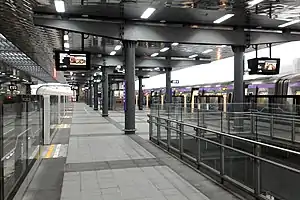 Chang Gung Memorial Hospital platform
Chang Gung Memorial Hospital platform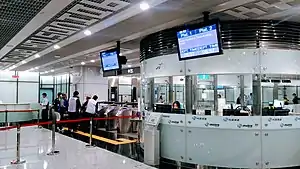 Airport Terminal 2 faregates and information booth
Airport Terminal 2 faregates and information booth
Ridership
Table below shows the daily average ridership per month.[68]
| Jan | Feb | Mar | Apr | May | Jun | Jul | Aug | Sep | Oct | Nov | Dec | Year | |
|---|---|---|---|---|---|---|---|---|---|---|---|---|---|
| 2017 | - | - | 66,715[note 4] | 57,431 | 53,075 | 52,485 | 53,358 | 57,981 | 52,379 | 57,652 | 53,890 | 63,706 | 56,867 |
| 2018 | 57,791 | 60,313 | 60,643 | 60,929 | 58,498 | 61,665 | 62,701 | 67,357 | 64,353 | 65,941 | 67,647 | 75,058 | 63,575 |
| 2019 | 69,360 | 71,525 | 70,824 | 72,810 | 72,080 | 75,929 | 77,830 | 79,805 | 76,235 | 83,208 | 79,969 | 89,204 | 76,565 |
| 2020 | 82,810 | 58,868 | 40,737 | 33,621 | 37,933 | 43,162 | 48,160 | 53,257 | 51,550 | 51,720 | 51,668 | 53,423 | 50,576 |
| 2021 | 46,793 | 41,855 | 49,168 | 50,673 | 27,172 | 14,197 | 18,872 | 29,476 | 33,598 | 42,215 | 46,668 | 51,258 | 37,662 |
| 2022 | 40,012 | 39,098 | 47,692 | 39,609 | 30,877 | 36,888 | 44,951 | 48,921 | 48,863 | 53,097 | 61,492 | 72,154 | 46,971 |
| 2023 | 69,207 | 74,697 | 78,160 | 79,755 | 80,102 | 84,347 | 92,396 | 100,574 |
Notes
- The cited source mentions 7 underground and 15 elevated stations, but includes a not-yet-opened station (Airport Terminal 3) in the underground station count.
- Express bound for Huanbei Service July 2020 schedule: From Chang Gung Memorial Hospital, 1 journey only: Weekday, 0606, From Taipei, 5-6 daily services: Weekday, 0700, 0800, 1600, 1700, 1800; Weekend, 1300, 1400, 1500, 1600, 1700, 1800. From Huanbei, 6 daily services: Weekday, 0729, 0814, 0914, 1714, 1814, 1914; Weekend, 1414, 1514, 1614, 1714, 1814, 1914.
- BOHSR later merged into the MOTC Railway Bureau.
- Ticket price 50% off during first month of operation (March 2017)
References
- "桃園捷運車輛簡介". club.ntu.edu.tw (in Chinese). Retrieved 4 February 2018.
- 為機捷營運需要很多汗水 請個別人士少一點口水. 桃園大眾捷運股份有限公司. 2017-05-26. Archived from the original on 2018-02-03. Retrieved 2017-06-06.
- 交通部高速鐵路工程局 (2011-05-19). "ME01號誌車載設備工廠測試出國報告". 國家發展委員會公務出國報告資訊網. p. 6. Retrieved 2018-10-07.
- "Taoyuan MRT operational information" (PDF). Taoyuan Metro. 1 October 2017. Retrieved 28 June 2020.
- "環狀線1/31正式通車 機捷A3站市區預辦登機、行李託運也來了" [Circular Line opens 1/31 as well as Taoyuan MRT A3 station In-Town Check-In] (in Chinese). Eastern Broadcasting Company. 30 January 2020. Retrieved 28 June 2020.
- "機場捷運延伸線計畫" [Taoyuan Airport MRT Extension Project] (in Chinese). Ministry of Transportation and Communications (Taiwan). 24 October 2019. Retrieved 28 June 2020.
- "The Project of Taiwan Taoyuan International Airport Access MRT System". Bureau of High Speed Rail, MOTC. Archived from the original on 2009-02-20. Retrieved 2010-12-09.
- "Taoyuan Metro Corporation Annual Report 2010-11" (PDF). Taoyuan Metro. Retrieved 28 June 2020.
- "FAQ (p6)". Taoyuan Metro. Retrieved 28 June 2020.
- "Timetable & Fare search". Taoyuan Metro. Retrieved 29 June 2020.
- "About the Services - Luggage Storage Area". Taoyuan Metro. Retrieved 29 June 2020.
- "New Taipei City launches free Wi-Fi services on buses". Taiwan Today. 13 December 2017. Retrieved 30 June 2020.
- "Taiwan Airport MRT". Ministry of Transportation and Communications (Taiwan). Retrieved 30 June 2020.
- "Taiwan Taoyuan International Airport Access MRT System Construction Project" (PDF). Ministry of Transportation and Communications. December 2009. Retrieved 2011-08-08.
- "Int'l airport MRT station to offer direct luggage checking". The China Post. 2011-11-02. Retrieved 2011-11-03.
- "Brief of Construction Tenders". Bureau of High Speed Rail, MOTC. Archived from the original on 2011-07-04. Retrieved 2011-01-05.
- "About the Services - flight information display system". Taoyuan Metro. Retrieved 29 June 2020.
- "Taoyuan Metro Fares" (PDF). Taoyuan Metro. Retrieved 4 July 2020.
- "Airport MRT fares to be cut NT$10 from October". Taipei Times. 17 July 2018. Retrieved 4 July 2020.
- "Taoyuam Metro Periodic Tickets". Taoyuan Metro. Retrieved 4 July 2020.
- "Periodic Ticket/Group Ticket". www.tymetro.com.tw (in Chinese (Taiwan)). Retrieved 20 December 2019.
- "Taoyuan Airport MRT". www.taoyuan-airport.com (in Chinese (Taiwan)). Retrieved 13 March 2017.
- 機捷車廂抵台 10月亮相. The Liberty Times. 2011-08-13. Archived from the original on 2013-04-19. Retrieved 2011-08-13.
- Wang, Shu-Fen (12 August 2011). "机捷车厢抵台 10月亮相" [First Taoyuan Airport MRT train car arrives in Taiwan]. dailynews.sina.com (in Chinese). Central News Agency (Taiwan). Retrieved 4 July 2020.
- 蘇, 昭旭 (2017). 世界捷運與輕軌百科. Taiwan: 人人出版. ISBN 9789864610877.
- 機場捷運車廂9月到 軌道測試 (in Simplified Chinese). 自由時報. 2011-02-25. Archived from the original on 2013-04-18. Retrieved 2011-02-24.
- "E&M Mechanical System Engineering". Department of High Speed Rail, MOTC. Retrieved 2011-01-06.
- "Rail crane wagon (RCW) is delivered to Taiwan airport railway". Hokuriku Heavy Industries. 19 September 2012. Retrieved 31 October 2019.
- "Rail inspection vehicle (RIV) is delivered to Taiwan airport railway". Hokuriku Heavy Industries. 20 September 2012. Retrieved 31 October 2019.
- "Four 60-ton locomotives are delivered to Taiwan airport railway (between Toen International Airport and Taipei)". Hokuriku Heavy Industries. 21 September 2012. Retrieved 31 October 2019.
- "機捷借來超音波探傷車 全面檢測鋼軌安全". China Times. 15 April 2017. Retrieved 12 March 2021.
- Kwok, Reginald (16 June 2005). Globalizing Taipei: The Political Economy of Spatial Development. Routledge. p. 197. ISBN 9780415354516.
- "機場捷運線百年大計 臺北車站特定區- -國家門戶" (in Chinese). Department of Rapid Transit Systems, Taipei City Government. 2005-09-01. Archived from the original on 28 January 2008. Retrieved 2011-01-05.
- "Twin towers to appear at airport MRT line". The China Post. 2006-09-26. Retrieved 2010-08-13.
- 台北中央駅空港高速線の駅デザイン (in Japanese). IKDS. September 2007. Retrieved 2011-02-24.
- "Redevelopment of Taipei Main Station Area". Maki and Associates. Archived from the original on 2009-10-03. Retrieved 2011-02-24.
- "專題報導 Special Report: 臺灣桃園國際機場聯外捷運系統 臺北站工程". Department of Rapid Transit Systesm. 2008-03-01. Retrieved 2010-06-19.
- "Lines under construction". Transportation Bureau, Taipei County. Retrieved 2010-12-01.
- "High speed rail bureau chief resigns over project delays". Taiwan News. 8 May 2013. Retrieved 2 March 2017.
- "Talk of the day -- Airport MRT line and expansion project in focus". Focus Taiwan News Channel. 2010-07-25. Retrieved 2010-07-28.
- "臺灣桃園國際機場聯外捷運系統工程 三重市轄段用地取得". Department of Rapid Transit Systems. 2007-11-01. Retrieved 2010-06-19.
- ""Development and Operation Project of Special Industrial Zone of HSR Taoyuan Station District" Requests for Opinions from Vendors". Department of High Speed Rail, MOTC. Retrieved 2011-01-06.
- "Kingdom to develop land near future Linkou MRT". The China Post. 2011-04-13. Retrieved 2011-04-15.
- 台北・中正国際空港鉄道建設契約を受注 (in Japanese). Marubeni. 2006-01-12. Retrieved 2011-02-24.
- "Hitachi Signed Contract for Airport Access MRT System in Taiwan". Hitachi. 2006-01-12. Archived from the original on 2011-07-11. Retrieved 2011-02-24.
- "The Groundbreaking Ceremony of Power Supply System for Taoyuan International Airport Access MRT System Construction Project". Department of High Speed Rail, MOTC. Retrieved 2011-01-06.
- "Motorola to Provide TETRA Radio Network for Taiwan Tao-Yuan Airport Link Transit System". Motorola. 2007-06-26. Retrieved 2011-02-24.
- "BOHSR Newsletter: Jul. 2011" (PDF). Bureau of High Speed Rail. July 2011. Retrieved 2011-08-06.
- "Contract Signing of Automatic Fare Collection System Works for Taoyuan International Airport Access MRT with Contractor". Bureau of High Speed Rail, MOTC. Retrieved 2011-01-06.
- "機場捷運七樓高 民眾憂安全". 新浪新聞. 2011-02-28. Archived from the original on 2011-03-02. Retrieved 2011-02-28.
- "關切機場捷運進度 吳志揚視察A8長庚醫院站". NOW News. 2011-03-24. Retrieved 2011-03-31.
- "Updates from APS Technology, Railinc, Wabtec, Bombardier, RAIL.ONE, David J. Joseph and Bowman, Barrett & Associates". Progressive Railroading. 2010-06-10. Retrieved 2010-06-30.
- "桃園機場捷運 V型橋工程即將完成". 自立晚報. 2011-04-15. Retrieved 2011-04-16.
- "Taiwan Taoyuan International Airport Access MRT System Construction Project Contract CU02". Continental Engineering Corporation. Retrieved 2011-02-24.
- 機場捷運線雙圓潛盾機設備之設計考量. Department of Rapid Transit Systems. 2008-03-01. Archived from the original on 2009-01-05. Retrieved 2010-06-19.
- Grace Kuo (2010-12-31). "Super tunnel digger speeds up Taipei MRT project". Taiwan Today. Retrieved 2010-12-31.
- "Cross passage of Shield Tunnel of Airport MRT & Bamboo-Cutting foundation Are to Be Completed with Great Expeditiousness". MOTC. 2010-07-23. Retrieved 2010-12-01.
- "Airport MRT begins commercial operations". The China Post. 2017-03-02. Retrieved 2017-03-02.
- "Airport MRT to begin commercial operations". The China Post. 2017-03-02. Retrieved 2017-03-02.
- 李順德 (2008-12-05). "再砸130億》機場捷運 延伸到中壢車站" (in Chinese). United Daily News. Archived from the original on 6 December 2008. Retrieved 2010-02-25.
- 「台灣桃園國際機場聯外捷運系統延伸至中壢火車站規劃報告」案 Archived 2011-07-21 at the Wayback Machine
- "機場捷運增設A2a站及A5a站計畫 - 路線說明" [Taoyuan Airport MRT Station A2a and A5a expansion plan - route description] (in Chinese). Department of Rapid Transit Systems, New Taipei City Government. 28 April 2020. Retrieved 5 July 2020.
- "捷運機場線增博愛站 站址確定" [Tayouan Airport MRT Boai station expansion] (in Chinese). Liberty Times. 11 November 2010. Archived from the original on 13 November 2010. Retrieved 5 July 2020.
- "機場捷運增設A2a站及A5a站計畫 - 辦理情形" [Taoyuan Airport MRT Station A2a and A5a expansion plan - current status] (in Chinese). Department of Rapid Transit Systems, New Taipei City Government. 28 April 2020. Retrieved 5 July 2020.
- "Public Art Sites Project Descriptions". MRT Engineering Office, Bureau of High Speed Rail. Archived from the original on 2012-03-15. Retrieved 2010-12-01.
- "Route map". Taoyuan Metro. Archived from the original on 20 February 2017. Retrieved 19 February 2017.
- "【TVBS】解密「桃捷逃生」 訪神秘站 爬15層逃生梯 - YouTube". www.youtube.com. Archived from the original on 2021-12-12. Retrieved 2020-08-06.
- "全系統旅運量統計". 桃園大眾捷運股份有限公司. Archived from the original on 2017-12-11. Retrieved 2017-12-11.
